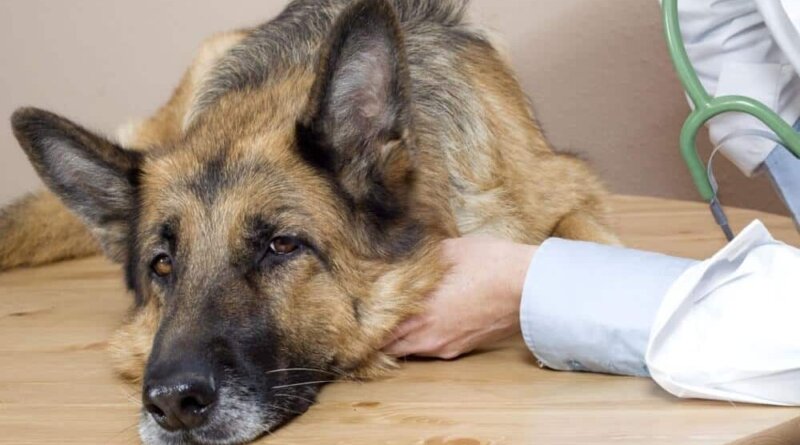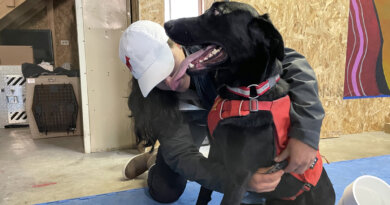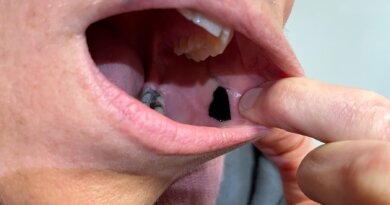Can Your Dog Catch the Flu?
By Nicole Pajer
UPDATE, January 30, 2018: Time.com recently reported on a breakout of dog flu in several states, including California. The strain affecting dogs is canine H3N2, a different strain than the similarly named human H3N2.
Flu season has arrived—for humans and dogs. As people march into medical centers to nab their annual vaccination, veterinarians across the country are recommending that dog owners consider a similar immunization for their four-legged companions.
The canine flu (H3N8) aka “the dog flu” is a contagious respiratory infection that was first discovered in 2004 when the virus jumped from horses and began affecting several breeds of racing dogs. Since then, 38 states have reported infected dogs, but, according to Dr. Edward J. Dubovi, Director of Virology at Cornell’s Animal Health Diagnostic Center, outbreaks tend to be sporadic and then dwindle. Fortunately, experts say that most cases are generally mild, can be treated if caught in time, and are preventative.
Here is some more information on the virus and how you can keep your dog healthy this holiday season:
How is Dog Flu Spread?
Since dogs have no natural immunity to this virus, canine influenza can be easily transmitted between dogs; an infected dog can pass it to another dog through aerosolized respiratory secretions (sneezing, panting, etc.). Infected dogs actively shedding the virus can directly transmit it to other dogs. The virus can also spread through canine contact with contaminated objects and by people who move between infected and uninfected dogs.
Dog-to-Dog Transmission of the Flu
Direct contact with infected dogs is the main route of dog-to-dog transmission of canine influenza. Nose-to-nose interactions allow the virus to spread through respiratory droplets. Sharing items like food bowls, toys, and bedding with sick dogs can also transfer virus particles and lead to infection. Settings like dog parks, daycares, and boarding facilities are high risk due to the number of dogs mingling nearby. Owners should be cautious about exposing their dogs in areas where canine influenza is suspected or confirmed. Keeping canines away from known infected animals and their items can reduce transmission risks.
Human Transmission
Humans can inadvertently spread canine influenza. Handling or touching infected dogs and then having contact with other pets can transfer the virus and cause transmission. Contaminated items like shoes, clothing, and hands can also spread virus particles from sick dogs to uninfected ones. Bringing objects like leashes or toys used with infected dogs into the home or around other dogs can also lead to the spread.
Airborne Transmission of Dog Influenza
Infected dogs can spread the flu directly through the air when they cough and sneeze. Respiratory droplets containing the viral particles can become aerosolized and remain suspended in the air for short distances. Air circulation can then spread these particles to other pets in close proximity. The risk of airborne transmission increases the closer uninfected dogs are to those actively shedding the virus when coughing or sneezing. Facilities housing multiple dogs in shared airspace may facilitate spread through heating, ventilation, and air conditioning systems.
Dog Flu Incubation Period
After infection with canine influenza, there is typically an incubation period of 2-3 days before dogs start to show symptoms. During this time, the virus is multiplying rapidly in respiratory tissues. Dogs are most contagious for about 10 days after becoming infected, even before the onset of coughing and other signs. Infected dogs begin shedding viral particles in nasal secretions and saliva up to 2 days before symptoms appear. This means dogs can already spread the virus while appearing healthy. Due to this potential for asymptomatic transmission, cautions like isolating dogs with suspected exposure and proper hygiene are important for containment. The incubation period allows the virus to gain momentum and make dogs contagious before immune responses fully mobilize. Understanding this lag time and shedding pattern is key for controlling outbreaks.
Symptoms of Canine Influenza
- Cough
- Fever
- Runny Nose
- Lethargy
- Loss of appetite
- Respiratory infection
According to veterinarian Shari Brown, signs of canine influenza can mimic kennel cough (a dry cough) but can also be a moist cough that persists for 7 to 30 days.
Dog Flu vs. Human Flu
Canine influenza and human influenza are different illnesses caused by different viruses. The viruses that cause dog flu only spread between dogs. The ones that cause human flu only spread between people. Both illnesses can cause cough, runny nose, and fever. But dog flu viruses don’t make humans sick very easily. And human flu viruses don’t make dogs sick very easily.
The time it takes for symptoms to start after infection is different for dog flu and human flu. The number of days when a dog or person is contagious is also different. The ways the viruses spread, like through coughs or shared toys, are similar. But vaccines for human flu don’t work for dog flu. Even though they are similar respiratory illnesses they are separate sicknesses caused by different viruses specific to their host.
There is little risk of dogs and people spreading their flu viruses to each other. But hand washing is still important if there are flu cases in both people and pets in one household. This helps avoid any accidental passing of the viruses through something like a shared toy.
What to Do if You Think Your Dog Has Influenza?
Brown recommends that If a Pack Leader notes a cough that lasts longer than two days combined with other symptoms (nasal discharge, difficulty breathing, lethargy, decreased appetite), they should see a veterinarian immediately. Your vet will perform a test to see if your dog has canine influenza and if he tests positive, will prescribe a treatment plan. Follow the below steps if you suspect your furry friend has the flu.
- Contact your veterinarian – they can confirm if symptoms match canine influenza and advise the next steps
- Isolate your dog from other pets immediately to limit the spread
- Look for symptoms including coughing, runny nose, fever, lethargy, reduced appetite
- Monitor your dog closely for difficulty breathing, dehydration, or other concerning symptoms
- Avoid dog parks/daycares and limit interactions with other dogs during illness
- Provide plenty of rest and a quiet, comfortable space for your dog to recover
- Make sure your dog has easy access to fresh water to stay hydrated
- Feed bland, soft foods if your dog has a decreased appetite
- Administer any medications prescribed by your vet as directed
- Clean and disinfect your home thoroughly to remove germs
- Contact your vet promptly if symptoms worsen or do not improve with time
- Monitor other pets closely for any signs of illness and isolate if needed

How is Dog Flu Treated?
Most canine influenza cases are considered mild and involve treatments consisting of supportive care. Dogs may be given several medications to make them feel more comfortable as well as fluids to ensure that they are properly hydrated. “Just like human flu, we will treat with antibiotics to help protect against secondary infections. With the severe form, dogs show signs of fevers and pneumonia. These dogs sometimes have to be hospitalized,” explains Brown. Canine influenza is usually self-limiting, but severe cases do occur. The recommended treatment consists of rest, hydration, and supportive veterinary care. Antibiotics may be prescribed if secondary infections develop. Strict isolation from other dogs is also advised to prevent the spread of the virus.
Veterinary Care
The first step is confirming the diagnosis through a physical exam and testing. Dogs that develop pneumonia or have severe symptoms may require hospitalization for more intensive care. Dehydration is common with flu, so administering intravenous fluids is often necessary. Throughout treatment, the veterinarian will monitor vital signs and oxygen levels to ensure the dog is stable. With supportive veterinary care such as testing, hospitalization, fluids, and monitoring, most dogs recover fully from canine influenza within 2 to 3 weeks. However, veterinary attention is key, as dogs can decline rapidly or develop secondary infections without proper care.
Medication for Treatment of Dog Influenza
Medication can be an important part of treating dogs with canine influenza. Antibiotics may be prescribed if a secondary bacterial infection occurs. In severe cases, antiviral medication may be used to help shorten the duration and reduce the severity of symptoms. Pain relievers are also sometimes administered if the dog is experiencing significant discomfort. Additionally, supplements that support the immune system, such as probiotics and omega-3 fatty acids, may be recommended. While most cases of canine flu are mild and self-limiting, medication under veterinary oversight can help manage secondary infections, relieve severe symptoms, and support the dog’s recovery process.
Home Care for Canine Flu
Caring for a dog with canine influenza at home involves several important steps. Isolation from other household pets is crucial to prevent disease spread. The dog needs plenty of uninterrupted rest to recover. Pack Leaders should provide clean, dry bedding and make water easily accessible to ensure proper hydration. Appetite may be reduced, so bland, soft foods are recommended to ease digestion. Monitoring appetite and bathroom habits can help identify any complications requiring veterinary attention. Overall, home care focuses on allowing rest, supporting nutrition and hydration, maintaining sanitary conditions, and watching for worsening symptoms. With attentive care at home in addition to veterinary treatment, most dogs can successfully recover from the flu.
Follow Up Care for Dog Flu
An essential part of recovering from canine influenza is diligent follow-up care. Pet owners should have periodic check-ins with the veterinarian to monitor the dog’s recovery status. They can also discuss options for ongoing symptom management if needed. Once fully recovered, vaccinating the dog is recommended to protect against future infection. In some cases, retesting may be advised to confirm the virus has been cleared from the body before ending isolation. As the dog is feeling better, activity and socialization can be slowly reintroduced, as long as they avoid contact with unvaccinated dogs. Staying engaged with the veterinarian allows pet owners to provide excellent aftercare to ensure complete recovery, prevent recurrence, and transition their dogs back to normal life after canine influenza.
Preventing the Dog Flu
Keeping your furry friend away from infected dogs is the best way to prevent canine influenza. If a pet owner is exposed to infected dogs or facilities, they should disinfect clothing, surfaces, and hands before contacting an uninfected dog. Vaccination against certain strains can provide protection but does not treat infected dogs. The vaccine involves two shots given weeks apart, costing around $50 each. Annual revaccination is recommended along with avoiding contact with infected dogs, as kennel cough vaccines do not guarantee flu protection. Pack Leaders should monitor boarding facilities for outbreaks and seek veterinary care immediately if symptoms appear. Though not foolproof, combining vigilance, vaccination, and prompt veterinary care offers the best protection against this contagious and potentially serious dog illness.
Should You Vaccinate Your Dog Against Canine Influenza?
The American Veterinary Medical Association’s stance is that dogs that are in frequent contact with other dogs should be vaccinated against canine influenza to help prevent the spread of the virus.
While the vaccination is advised in high-risk infection areas, many veterinarians, like Dubovi, recommend that owners make a risk assessment before deciding whether or not to vaccinate.
“CIV is transmitted most efficiently with dogs in close contact—kennels, shelters, daycare facilities, and perhaps dog parks. In those enzootic regions, dogs in these risk categories may benefit from vaccination just as they would from the standard respiratory vaccines. The other risk group is those that do dog rescue work where dogs are moved from enzootic areas to areas without a history of infection,” says Dubovi.
Brown says that although her veterinary clinic is not in an “infected zone,” they still administer the vaccinations because some boarding facilities are starting to require it before accepting dogs. “It may also be recommended for dogs that are in doggie daycare every day (being in an area with multiple dogs allows the virus to spread more easily),” she explains.
While the vaccine will significantly lower the odds of your dog coming down with canine influenza, it’s important to note that it only protects against certain strains and therefore won’t guarantee that your dog won’t get the flu. Owners should assess whether or not their dog should be vaccinated based on the lifestyle of their pet. Even vaccinated dogs should be kept away from people, objects, and dogs that have come into direct contact with the virus. If your dog becomes sick, don’t panic. Take him to the vet and follow the suggested treatment plan. This virus is generally mild and if properly treated, infected dogs should experience a full recovery.
Has your dog ever caught the flu? How was it?




